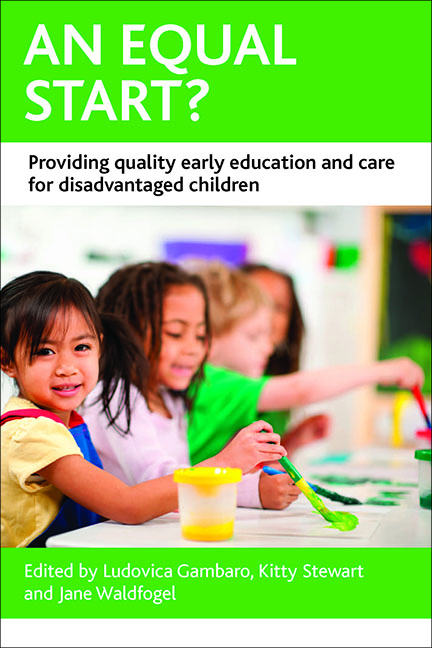Book contents
- Frontmatter
- Contents
- List of figures, tables and appendices
- Acknowledgements
- Notes on contributors
- one Introduction
- two Equal access to early childhood education and care? The case of the UK
- three Towards universal quality early childhood education and care: The Norwegian model
- four Equal access to quality care: Lessons from France on providing high-quality and affordable early childhood education and care
- five Equal access to high-quality childcare in the Netherlands
- six Access and quality issues in early childhood education and care: The case of Germany
- seven New Zealand: A narrative of shifting policy directions for early childhood education and care
- eight Early education and care in Australia: Equity in a mixed market-based system?
- nine Delivering high-quality early childhood education and care to low-income children: How well is the US doing?
- ten Common challenges, lessons for policy
- Index
two - Equal access to early childhood education and care? The case of the UK
Published online by Cambridge University Press: 03 February 2022
- Frontmatter
- Contents
- List of figures, tables and appendices
- Acknowledgements
- Notes on contributors
- one Introduction
- two Equal access to early childhood education and care? The case of the UK
- three Towards universal quality early childhood education and care: The Norwegian model
- four Equal access to quality care: Lessons from France on providing high-quality and affordable early childhood education and care
- five Equal access to high-quality childcare in the Netherlands
- six Access and quality issues in early childhood education and care: The case of Germany
- seven New Zealand: A narrative of shifting policy directions for early childhood education and care
- eight Early education and care in Australia: Equity in a mixed market-based system?
- nine Delivering high-quality early childhood education and care to low-income children: How well is the US doing?
- ten Common challenges, lessons for policy
- Index
Summary
Introduction
Early childhood education and care (ECEC) has occupied an important place on the political agenda in the UK since the mid-1990s. Under the Labour government in office from 1997 to 2010, the expansion of childcare was seen as a crucial plank in the campaign against child poverty. At the same time, increasing evidence pointed to the importance of early education in promoting more equal life chances, suggesting the ‘double dividend’ which could be delivered by high-quality ECEC (DfES et al, 2002: 29). Spending on services for children under five increased threefold in real terms between 1997 and 2007, faster than spending on any other policy area (Sefton, 2009). The Conservative–Liberal Democrat Coalition government, which took office in 2010, has so far reduced support for childcare subsidies, but remains committed to early education, including expansions to disadvantaged two-year-olds, as part of its social mobility agenda.
While provision has come a long way in 15 years, there are still considerable gaps and challenges in the extent to which disadvantaged children access high-quality ECEC. Only a minority of children under three experience any formal childcare, which remains relatively expensive, and the available evidence suggests that more disadvantaged children are less likely to attend. Part-time nursery provision for three-and four-year-olds is free and nearly universal, but still has gaps, especially for three-year-olds. Quality has improved on several different measures, but continues to vary widely.
This chapter sets out the main policies governing ECEC provision for children under five in the UK, and asks how effectively these operate to ensure equality of access to high-quality services. We begin by describing the system of provision in the UK and patterns of usage. From here we look at the evidence on differences in attendance and quality of provision among children. Finally, we consider the link between these patterns and the policy framework.
The story is complicated by the fact that the UK has four constituent nations – England (where 84% of the UK population live), Scotland (8%), Wales (5%) and Northern Ireland (3%). While control over taxation is retained by the UK Parliament in Westminster, the devolved administrations for Scotland, Wales and Northern Ireland have authority over most domestic policy areas, including education and ECEC policy.
- Type
- Chapter
- Information
- An Equal Start?Providing Quality Early Education and Care for Disadvantaged Children, pp. 29 - 52Publisher: Bristol University PressPrint publication year: 2014

